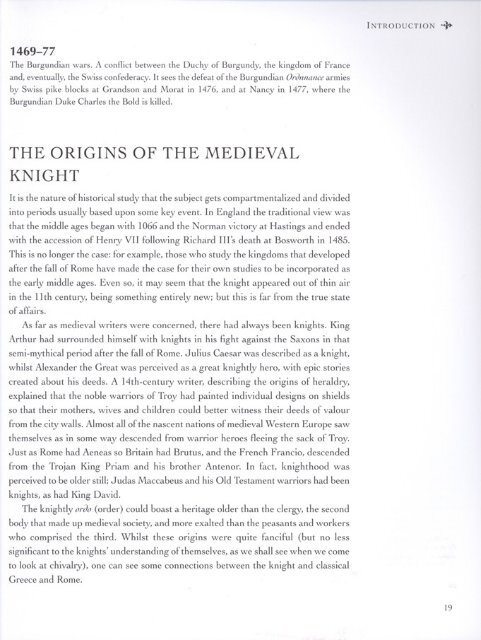Osprey - General Military - Knight - The Warrior and ... - Brego-weard
Osprey - General Military - Knight - The Warrior and ... - Brego-weard
Osprey - General Military - Knight - The Warrior and ... - Brego-weard
Create successful ePaper yourself
Turn your PDF publications into a flip-book with our unique Google optimized e-Paper software.
1469-77<br />
<strong>The</strong> Burgundian wars. A conflict between the Duchy of Burgundy, the kingdom of France<br />
<strong>and</strong>, eventually, the Swiss confederacy. It sees the defeat of the Burgundian Ordnnance armies<br />
by Swiss pike blocks at Gr<strong>and</strong>son <strong>and</strong> Morat in 1476, <strong>and</strong> at Nancy in 1477, where the<br />
Burgundian Duke Charles the Bold is killed.<br />
THE ORIGINS OF THE MEDIEVAL<br />
KNIGHT<br />
It is the nature of historical study that the subject gets compartmentalized <strong>and</strong> divided<br />
into periods usually based upon some key event. In Engl<strong>and</strong> the traditional view was<br />
that the middle ages began with 1066 <strong>and</strong> the Norman victory at Hastings <strong>and</strong> ended<br />
with the accession of Henry VII following Richard Ill's death at Bosworth in 1485.<br />
This is no longer the case: for example, those who study the kingdoms that developed<br />
after the fall of Rome have made the case for their own studies to be incorporated as<br />
the early middle ages. Even so, it may seem that the knight appeared out of thin air<br />
in the 11th century, being something entirely new; but this is far from the true state<br />
of affairs.<br />
As far as medieval writers were concerned, there had always been knights. King<br />
Arthur had surrounded himself with knights in his fight against the Saxons in that<br />
semi-mythical period after the fall of Rome. Julius Caesar was described as a knight,<br />
whilst Alex<strong>and</strong>er the Great was perceived as a great knightly hero, with epic stories<br />
created about his deeds. A 14th-century writer, describing the origins of heraldiy,<br />
explained that the noble warriors of Troy had painted individual designs on shields<br />
so that their mothers, wives <strong>and</strong> children could better witness their deeds of valour<br />
from the city walls. Almost all of the nascent nations of medieval Western Europe saw<br />
themselves as in some way descended from warrior heroes fleeing the sack of Troy.<br />
Just as Rome had Aeneas so Britain had Brutus, <strong>and</strong> the French Francio, descended<br />
from the Trojan King Priam <strong>and</strong> his brother Antenor. In fact, knighthood was<br />
perceived to be older still; Judas Maccabeus <strong>and</strong> his Old Testament warriors had been<br />
knights, as had King David.<br />
<strong>The</strong> knightly ordo (order) could boast a heritage older than the clergy, the second<br />
body that made up medieval society, <strong>and</strong> more exalted than the peasants <strong>and</strong> workers<br />
who comprised the third. Whilst these origins were quite fanciful (but no less<br />
significant to the knights' underst<strong>and</strong>ing of themselves, as we shall see when we come<br />
to look at chivalry), one can see some connections between the knight <strong>and</strong> classical<br />
Greece <strong>and</strong> Rome.<br />
INTRODUCTION -<br />
19







